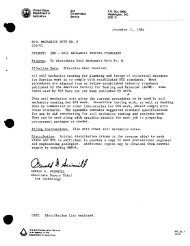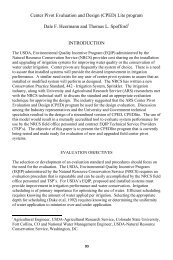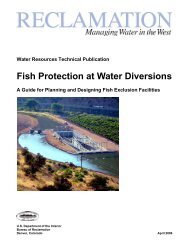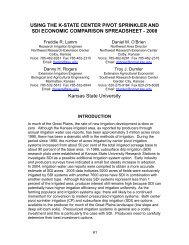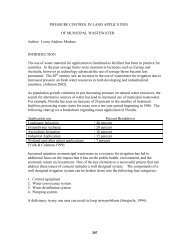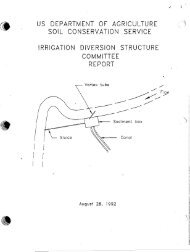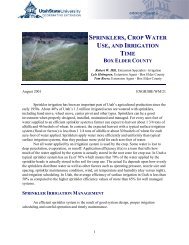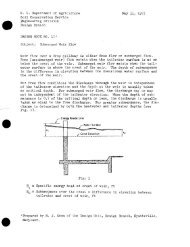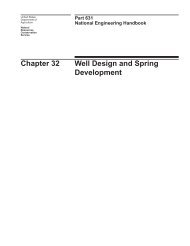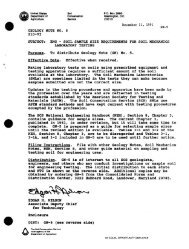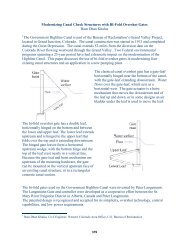NEH 16 Chapter 1 - NRCS Irrigation ToolBox Home Page
NEH 16 Chapter 1 - NRCS Irrigation ToolBox Home Page
NEH 16 Chapter 1 - NRCS Irrigation ToolBox Home Page
You also want an ePaper? Increase the reach of your titles
YUMPU automatically turns print PDFs into web optimized ePapers that Google loves.
occur where the soil is either slowly or rapidly permeable, where the climate iseither humid or arid, and where the land is either sloping or flat.For these reasons, it is convenient to classify subsurface-drainage problems bythe source of excess ground water and the way it moves into and through theproblem area. This method of identifying subsurface conditions is especiallyuseful for the more complex drainage problems because it also indicates the kindof drainage system needed. The reconnaissance and preliminary surveys are carriedout to obtain the needed information on ground-water occurrence and othersite conditions. Detailed information is in <strong>Chapter</strong> 2, Drainage Investigations.As experience with subsurface-drainage problems accumulates for a given area,the amount of preliminary information needed to identify certain problem typesusually is reduced. New areas or new kinds of drainage problems require greateremphasis at the preliminary stage of planning.The following examples illustrate some of the more important types of subsurfacedrainageproblems. Particular emphasis is given to the source and direction ofground-water flow. Detailed design of drainage systems for subsurface drainageis discussed in <strong>Chapter</strong> 4, Subsurface Drainage. Refer to the figures in <strong>Chapter</strong>4 for illustration of most of the drainage problems described below.Basin-type free-water tableIn valley bottoms and on wide benchlands, the free ground water saturates thesediments down to the first impervious barrier. Typically, the water tableslopes gently downvalley. This large, very slowly moving body of ground wateris fed by springs, surface streams, or subsurface percolation around the perimeterof the valley; and by infiltrating rainfall, irrigation losses, or surfacerunoff on the valley floor itself. Eventually, the ground water dischargeseffluent seepage at streambanks or at the ground surface in low areas, or exceptfor ground water used by plants or that pumped from wells, it escapes throughaquifers at the lower end of the valley or benchland. Height of the water tablefluctuates with the seasonal variation of accretions to the ground-water basin.The general slope of the water table varies only slightly in response to thesechanges in inflow. Where salts are present in the soil, they tend to move upwardto the surface as capillary rise replenishes the evaporation from the ground.Phreatophytes grow where the water table is close to or at the surface.Relief drains may be used to lower the water table in such areas, unless soilpermeability is too low. The ground-water slope is too nearly flat and thepervious sediments are too deep for efficient interception (except, perhaps, atthe sides of valleys near the base of the hills or the alluvial cones). Whereeconomically feasible, pumped-drainage wells are sometimes used to lower thebasin-type water table.Water table over an artesian aquiferGround water may be confined in an aquifer so that its pressure surface (elevationto which i; would rise in a weli tapping the aquifer) is higher than theadjacent free-water table. The pressure surface may or may not be higher thanthe ground surface. Such ground water is termed artesian. Pressure in theaquifer is from the weight of a continuous body of water extending to a sourcehigher than the pressure surface. Leaks at holes or weak points in the confininglayer above the aquifer create an upward flow, with hydraulic head decreasing inthe upward direction. The ground water moves in response to this hydraulicgradient and escapes as seepage at the ground surface above, or it escapeslaterally through other aquifers above the confining layer.



